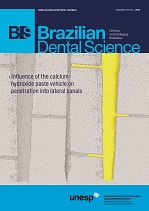Effect of thermocycling aging on the flexural strength of feldspathic ceramic
DOI:
https://doi.org/10.14295/bds.2018.v21i3.1554Resumo
Objective: The aim of the study was to evaluate the effect of aging through different thermocycling protocols on the flexural strength of a feldspathic ceramic. Material and Methods: Fifty ceramic bars, Vitablock Mark II (VITA), with dimensions of 18X4X2mm were prepared. The bars were randomly distributed to the groups (n = 10), which were defined according to the number of thermal cycles (TCy): G0 - no TCy; G500 - 500 cycles of TCy; G6000 - 6000 TCy; G10000 - 10000 TCy; G15000 - 15000 TCy. After aging, the specimens were subjected to the three point bending test in a universal testing machine (EMIC DL 1000), under 0.5mm/min speed and loading of 50kgf, until catastrophic failure. A sample of each group was evaluated for topographic morphology under Scanning Electron Microscopy. Results: For mechanical testing, the following mean values and standard deviation (MPa) were obtained: G0 (99.78 ± 5.07); G500 (101.64 ± 5.59); G6000 (98.13 ± 4.95); G10000 (91.77 ± 9.68); G15000 (101.51 ± 4.22). An analysis of variance by regression equation (p = 0.387) was performed, demonstrating a weak and non-significant correlation between flexural strength and number of thermal cycles. Conclusion: It can be concluded that aging in water solely by different numbers of temperature cycles did not influence on the flexural strength of a feldspathic ceramic.
Keywords
Material resistance; Aging; Ceramics.
Downloads
Downloads
Publicado
Como Citar
Edição
Seção
Licença
TRANSFERÊNCIA DE DIREITOS AUTORAIS E DECLARAÇÃO DE RESPONSABILIDADE
Toda a propriedade de direitos autorais do artigo "____________________________________________________________________" é transferido do autor(es) para a CIÊNCIA ODONTOLÓGICA BRASILEIRA, no caso do trabalho ser publicado. O artigo não foi publicado em outro lugar e não foi submetido simultaneamente para publicação em outra revista.
Vimos por meio deste, atestar que trabalho é original e não apresenta dados manipulados, fraude ou plágio. Fizemos contribuição científica significativa para o estudo e estamos cientes dos dados apresentados e de acordo com a versão final do artigo. Assumimos total responsabilidade pelos aspectos éticos do estudo.
Este texto deve ser impresso e assinado por todos os autores. A versão digitalizada deverá ser apresentada como arquivo suplementar durante o processo de submissão.




























